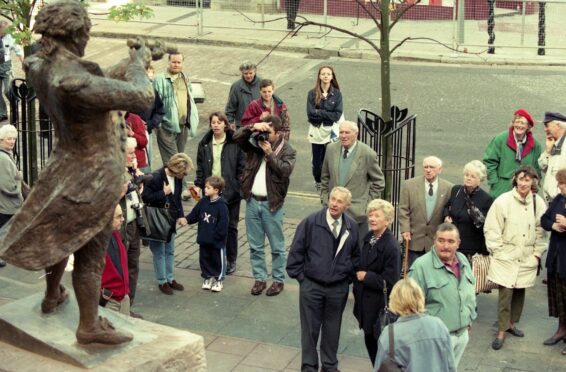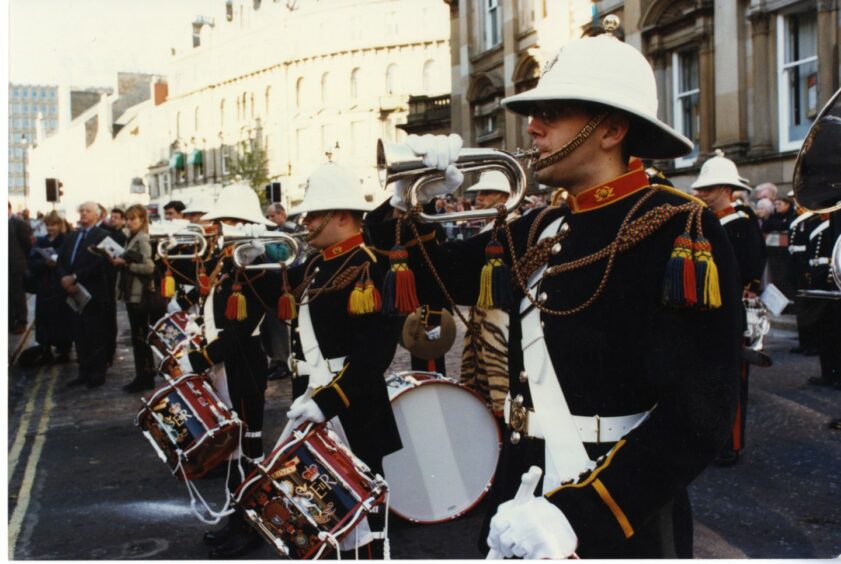Today marks the 225th anniversary of Admiral Duncan’s famous victory at the Battle of Camperdown in 1797.
The city centre will be slightly quieter today than it was 25 years ago when crowds lined the streets to celebrate one of its most famous sons and the bicentenary of his naval victory over the Dutch with over 1,000 people taking part in the special parade.
The focal point of the day’s celebrations was the unveiling of a statue of Admiral Duncan, in nautical pose, by the Earl of Dundee, outside St Paul’s Cathedral.
Duncan’s actions at the Battle of Camperdown had made him a national hero and it was fitting that his birthplace afforded him a statue 200 years later.
We have opened our archives to take a look back at that day 25 years ago.
Who was Admiral Duncan?
Adam Duncan was born in Dundee in 1731, and was the second son of the then Provost of Dundee, Alexander Duncan.
After his schooling in Dundee, Adam Duncan joined the Navy in 1746, aged 14.
A distinguished naval career saw him rise to the rank of Commander-in-Chief of the North Sea Fleet by the time he faced his most important battle in 1797.
In the 1790s, the French had one of the strongest armies in the world.
They had a series of victories behind them by the time they met Duncan at Camperdown, defeating their opposition all over Europe.
Britain was their next target, but Duncan was determined they would not take her despite their resources – the Redcoats and Royal Navy – being stretched far and wide.
The French planned to land in Edinburgh with the help and support of the Dutch.
Together with their allies in Ireland, they planned to overthrow King George III.
The only thing standing in the way was the British Home Fleet, and Admiral Duncan.
The Home Fleet itself was nothing to be proud of.
Its resources were running thin, and the handful of warships they did have were in worsening condition.
These fragile ships were crewed by a team of unhappy and near-mutinous sailors, who had only their good training to redeem themselves.
On October 11 1797, Dutch Admiral Jan Willem de Winter commanded his fleet to sail out off the coast of Holland, near Kamperduin.
Their orders were to remove the Royal Navy from the invasion path.
Admiral Duncan, at 6ft 6in, was a significant man who was scared of nothing.
It was this that ensured the fleets were evenly matched when they sailed out to fight the Dutch that day.
The fighting at the Battle of Camperdown raged for two-and-a-half hours.
It was a constant barrage of attacks.
Camperdown was the Battle of Britain of its day and Duncan’s success prevented a disastrous invasion.
The aftermath of the Battle of Camperdown
Eleven out of 25 Dutch ships were captured, including their flagship, Vrijheid.
The failing British ships were too damaged to pursue the rest.
Two-hundred-and-twenty British sailors were killed, and 812 were wounded, while the Dutch casualties stood at 540 killed and 620 wounded.
The battle represented the largest naval engagement in the Revolutionary Wars.
Famous paintings such as De Loutherbourg’s “The Battle of Camperdown” went on to depict the decisive moment when the British flagship Venerable fired its last broadside at the Dutch flagship Vryhied.
Although now eclipsed by other triumphs, such as Nelson’s win at Trafalgar in the following decade, Camperdown was widely celebrated by the British public at the time and was considered one of the nation’s most significant naval victories.
The battle prompted a significant boost to national morale, which was at an all-time low since the fleet had suffered several mutinies the year before.
Duncan was made Viscount of Camperdown and awarded the largest pension ever offered by the British Government.
Britain exulted in news of his triumph.
Guns were fired and church bells rang.
A state thanksgiving service was held at St Paul’s Cathedral in London, and when Duncan was invited to dine with the Lord Mayor his “chariot” was drawn by cheering crowds down Fleet Street and all the way to the Guildhall.
Admiral Duncan was afforded a statue in Dundee in 1997.
That’s when the huge parade followed.
Over 1,000 marchers led the charge towards the statue in the Seagate.
Hundreds of Dundonians turned up to watch the brass and pipe bands on their journey.
The memorial ceremony was led by Royal Navy chaplain Rev Scott Shackleton.
Shackleton was joined by representatives of the Royal Netherlands Navy, and Lord Provost Mervyn Rolfe.
A Royal Ensign flag was then pulled back to reveal the monument, which was carved by Janet Wedderburn Scymgeour of Cupar.
The city’s celebrations for Admiral Duncan didn’t end there.
The city council also commissioned a piece of music that was performed at the celebrations.
Internationally-renowned Dundee composer Gordon McPherson was chosen as the artist.
McPherson was also the composer-in-residence at the Royal Scottish Academy of Music and Drama in Glasgow.
He wrote a short piece with a nautical theme that was performed in Dundee as part of the bicentenary festivities.
It was also heard again when it was played by the Royal Scottish National Orchestra as part of its 1997/98 season.
The parade was hailed a huge success.
The statue of Admiral Duncan still stands today.
It’s a fitting and lasting memorial to one of Dundee’s greatest sons.























Conversation